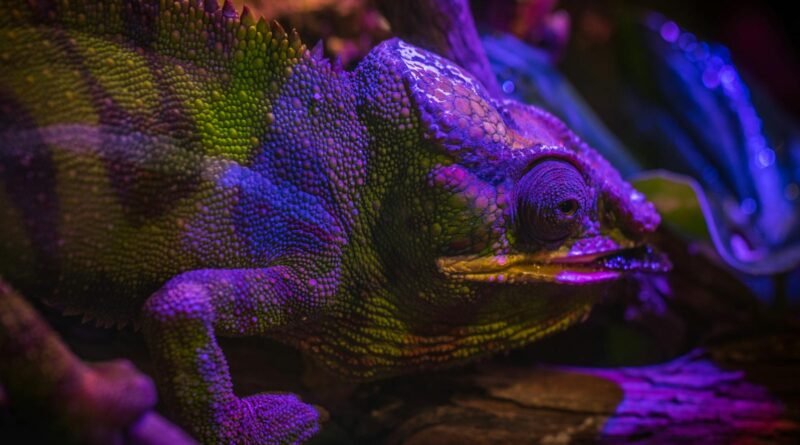10 Facts About Chameleons
By
Among the most fascinating and unnerving animals on earth, chameleons are endowed with so many unique adaptations—independently rotating eyes, shooting tongues, prehensile tails, and (last but not least) the ability to change their color—that they seem to have been dropped out of the sky from another planet. Discover 10 essential facts about chameleons, from the origins of their name to their ability to see ultraviolet light.
01
of 10
Oldest Identified Lived 60 Million Years Ago
:max_bytes(150000):strip_icc():format(webp)/chameleonWC5-587e43b13df78c17b6571ec6.jpg)
As far as paleontologists can tell, the first chameleons evolved shortly after the extinction of dinosaurs 65 million years ago. The earliest identified species, Anqingosaurus brevicephalus, lived in middle Paleocene Asia. However, there is some indirect evidence that chameleons were extant 100 million years ago, during the middle Cretaceous period, perhaps originating in Africa, which would explain their profusion in Madagascar. Most tellingly, and logically, chameleons had to share a last common ancestor with closely related iguanas and “dragon lizards,” a “concestor” who likely lived toward the end of the Mesozoic Era.
02
of 10
Over 200 Species
:max_bytes(150000):strip_icc():format(webp)/GettyImages-503342168-5c9938f0bed441508f19e7f62b1fb7d5.jpg)
Classified as “old world” lizards because they’re only indigenous to Africa and Eurasia, chameleons consist of a dozen named genera and over 200 individual species. Broadly speaking, these reptiles are characterized by their small size, quadrupedal postures, extrudable tongues, and independently rotating eyes. Most species also have a prehensile tail and the ability to change color, which signals to other chameleons and camouflages them. Most chameleons are insectivores, but a few larger varieties supplement their diets with small lizards and birds.
03
of 10
“Chameleon” Means “Ground Lion”
:max_bytes(150000):strip_icc():format(webp)/chameleonWC4-587e42ce5f9b584db3cdae52.jpg)
Chameleons, like most animals, have been around a lot longer than humans, which explains why we find references to this reptile in the oldest available written sources. The Akkadians—an ancient culture that dominated modern-day Iraq over 4,000 years ago—called this lizard nes qaqqari, literally “lion of the ground,” and this usage was picked up unaltered by subsequent civilizations over the ensuing centuries: first the Greek “khamaileon,” then the Latin “chamaeleon,” and finally the modern English “chameleon,” meaning “ground lion.”
04
of 10
Almost Half the Population Lives in Madagascar
:max_bytes(150000):strip_icc():format(webp)/GettyImages-1183067967-a4e489df27fe4303a932e1b85dacc9b9.jpg)
The island of Madagascar off the eastern coast of Africa is known for its diversity of lemurs (a tree-dwelling family of primates) and chameleons. Three chameleon genera (brookesia, calumma, and furcifer) are exclusive to Madagascar, with species including the caterpillar-sized pygmy leaf chameleon, the giant (nearly two-pound) Parson’s chameleon, the brightly colored panther chameleon, and the seriously endangered Tarzan chameleon (named not after the Tarzan of storybooks, but the nearby village of Tarzanville).
05
of 10
Most Change Colors
:max_bytes(150000):strip_icc():format(webp)/GettyImages-1186792030-03501c3213c7419a8a493334419754f4.jpg)
While chameleons aren’t quite as adept at blending in with their surroundings as they’re depicted in cartoons—they cannot become invisible or transparent, nor can they mimic polka dots or plaid—these reptiles are still very talented. Most chameleons can change their color, and pattern, by manipulating the pigments and crystals of guanine (a type of amino acid) embedded in their skin. This trick comes in handy for hiding from predators (or curious humans), but most chameleons change color to signal to other chameleons. For example, bright-colored chameleons are dominant in male-on-male contests, while more muted colors indicate defeat and submission.
06
of 10
Seeing Ultraviolet Light
:max_bytes(150000):strip_icc():format(webp)/3845407728_a1b1ba1ee5_o-5c8d4e4e46e0fb000146ad28-b939712ddaf84caf82253546c9334479.jpg)
UV radiation has more energy than “visible” light detected by humans and can be dangerous in large doses. One of the most mysterious things about chameleons is their ability to see light in the ultraviolet spectrum. Presumably, their ultraviolet sense evolved to allow chameleons to better target their prey. It may also have something to do with the fact that chameleons become more active, social, and interested in breeding when exposed to UV rays, possibly because UV light stimulates the pineal glands in their tiny brains.
07
of 10
Independently Moving Eyes
:max_bytes(150000):strip_icc():format(webp)/3468251441_9bd4b4c246_o-5c8d475946e0fb00016ee0b2-80aa4688bf2c497ea01e6e0e25a7c579.jpg)
For many people, the most disquieting thing about chameleons is their eyes, which move independently in their sockets and thus provide a near-360-degree scope of vision. In addition to perceiving UV light, they’re great judges of distance, because each eye has excellent depth perception. This allows the lizard to zero in on tasty prey insects from up to 20 feet away without binocular vision. Balancing its excellent sense of sight somewhat, chameleons have relatively primitive ears, and can only hear sounds in an extremely restricted range of frequencies.
08
of 10
Long, Sticky Tongues
:max_bytes(150000):strip_icc():format(webp)/GettyImages-722224879-36134e1c34b144d0bea0b758533c36a4.jpg)
The independently swerving eyes of a chameleon wouldn’t do much good if it couldn’t close the deal on prey. That’s why all chameleons are equipped with long, sticky tongues—often two or three times the length of their bodies—which they forcefully eject from their mouths. Chameleons have two unique muscles to accomplish this task: the accelerator muscle, which launches the tongue at high speed, and the hypoglossus, which snaps it back with the prey attached to the end. Amazingly, a chameleon can launch its tongue at full force even in temperatures low enough to make other reptiles extremely sluggish.
09
of 10
Extremely Specialized Feet
:max_bytes(150000):strip_icc():format(webp)/GettyImages-1095051788-0e69a5ae355e4eae93fd5d6d2b474485.jpg)
Perhaps because of the extreme recoil caused by its ejecting tongue, chameleons need a way to stay firmly attached to the branches of trees. Nature’s solution is “zygodactylous” feet. A chameleon has two outer and three inner toes on its front feet, and two inner and three outer toes on its hind feet. Each toe features a sharp nail that digs into tree bark. Other animals—including perching birds and sloths—also evolved a similar anchoring strategy, though the five-toed anatomy of chameleons is unique.
10
of 10
Most Have Prehensile Tails
:max_bytes(150000):strip_icc():format(webp)/GettyImages-1181604599-01bdd17707f74488b1e7914f5d8daca2.jpg)
As if their zygodactylous feet weren’t enough, most chameleons (except for the very smallest) also have prehensile tails to wrap around tree branches. Their tails afford chameleons greater flexibility and stability when climbing up or down trees and, like their feet, help brace against the recoil of an explosive tongue. When a chameleon is resting, its tail is curled up into a tight ball. Unlike some other lizards that can shed and regrow their tails numerous times throughout their lifetimes, a chameleon can’t regenerate its tail if it’s cut off.
Strauss, Bob. “10 Facts About Chameleons.” ThoughtCo. https://www.thoughtco.com/facts-about-chameleons-4123639 (accessed July 22, 2024).



:max_bytes(150000):strip_icc():format(jpeg)/bhg-kitchen-cabinets-lighting-8687591-da71094668bb4bc2a4c1ee895b7df5ff.png)
